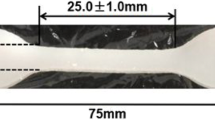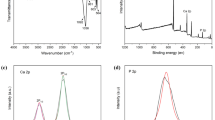Abstract
In this work, doubly physically crosslinked hydrogels were synthesized, based on poly(N-isopropylacrylamide) containing 10 mol% of methacrylate co-monomer, in which nano-platelets of hectorite clay acted as the primary strong physical crosslinker, and trivalent cations La3+, Fe3+, and Al3+ as an additional dynamic one. Due to their excellent mechanical and tensile properties, such gels might be of interest as advanced structural materials for soft robotics. Of especial scientific interest was the comparison of the seemingly similar trivalent cations embedded in analogous gels, where their different bonding to carboxylate made dramatic differences concerning the material properties: La3+—purely electrostatic and highly dynamic bonding, Fe3+—with tendency to coordination-covalent-, and Al3+—with a rather covalent bonding. The cations incorporated into the hydrogels caused a marked, or even very strong improvement of tensile toughness, which in case of La3+ occurred without reducing the extensibility. All the cations expectedly raised the modulus: the effect was most pronounced with Al3+, which tends to covalent bonding. Most importantly, all the cations improved the kinetics of internal self-healing (self-recovery) of the gels, which was fastest with the dynamically (purely electrostatically) bonding La3+ (complete recovery of properties in 1 h). All the cations were incorporated via impregnation of precursor gels. An original synthesis aspect was, that the impregnation was conducted for a brief period of time, which was found necessary to achieve maximum modulus (the modulus dropped again at longer times). In this way, a non-stoichiometric (usually sub-stoichiometric) amount was incorporated, which made a subsequent extraction of cation excess unnecessary. Additionally, the non-stoichiometry helped the self-healing (network reorganization), which was most striking in case of the rather covalently bonding Al-impregnated gel.















Similar content being viewed by others
Data availability
The raw/processed data required to reproduce these findings cannot be shared at this time due to technical or time limitations.
References
Wichterle O, Lím D (1960) Hydrophilic gels for biological use. Nature 185:117–118
Li Z, Chen L, Xu M, Ma Y, Chen L, Dai F (2020) Double crosslinking hydrogel with tunable properties for potential biomedical application. J Polym Res 27:262
Lee KY, Mooney DJ (2001) Hydrogels for tissue engineering. Chem Rev 101:1869–1879
Kopecek J (2007) Hydrogel biomaterials: a smart future? Biomaterials 28:5185–5192
Calvert P (2009) Hydrogels for soft machines. Adv Mater 21:743–756
Haque MA, Kurokawa T, Gong JP (2012) Super tough double network hydrogels and their application as biomaterials. Polymer 53:1805–1822
Tanaka Y, Fukao K, Miyamoto Y (2000) Fracture energy of gels. Eur Phys J E 3:395–401
Lin WC, Fan W, Marcellan A, Hourdet D, Creton C (2010) Large strain and fracture properties of poly(dimethylacrylamide)/silica hybrid hydrogels. Macromolecules 43:2554–2563
Strachota B, Šlouf M, Matějka L (2017) Tremendous reinforcing, pore-stabilizing and response-accelerating effect of in situ generated nanosilica in thermoresponsive poly(N-isopropylacrylamide) cryogels. Polym Int 66:1510–1521
Lutecki M, Strachotová B, Uchman M, Brus J, Pleštil J, Šlouf M, Strachota A, Matějka L (2006) Thermosensitive PNIPA-based organic-inorganic hydrogels. Polym J 38:527–541
Xu B, Li H, Wang Y, Zhang G, Zhang Q (2013) Nanocomposite hydrogels with high strength cross-linked by titania. RSC Adv 3:7233–7236
Huerta Angeles G, Hishchak K, Strachota A, Strachota B, Šlouf M, Matějka L (2014) Super-porous nanocomposite PNIPAmhydrogels reinforced with titania nanoparticles, displaying a very fast temperature response as well as pH-sensitivity. Eur Polym J 59:341–352
Gong JP, Katsuyama Y, Kurokawa T, Osada Y (2003) Double-network hydrogels with extremely high mechanical strength. Adv Mater 15:1155–1158
Fei X, Xu S, Feng S, Lin JL, Lin JT, Shi XM, Wang JD (2011) Mechanically strengthened double network composite hydrogels with high water content: a preliminary study. J Polym Res 18:1131–1136
Sun JY, Zhao X, Illeperuma WRK, Chaudhuri O, Oh KH, Mooney DJ, Vlassak JJ, Suo Z (2012) Highly stretchable and tough hydrogels. Nature 489:133–136
Bin Imran A, Esaki K, Gotoh H, Seki T, Ito K, Sakai Y, Takeoka Y (2014) Extremely stretchable thermosensitive hydrogels by introducing slide-ring polyrotaxane crosslinkers and ionic groups into the polymer network. Nat Commun 5:5124
Song GS, Zhang L, He CC, Fang DC, Whitten PG, Wang HL (2013) Facile fabrication of tough hydrogels physically cross- linked by strong cooperative hydrogen bonding. Macromolecules 46:7423–7435
Matsunaga T, Sakai T, Akagi Y, Chung UI, Shibayama M (2009) SANS and SLS studies on tetra-arm PEG gels in as-prepared and swollen states. Macromolecules 42:6245–6252
Haraguchi K, Takehisa T (2002) Nanocomposite hydrogels: a unique organic-inorganic network structure with extraordinary mechanical, optical, and swelling/de-swelling properties. Adv Mater 14:1120–1124
Haraguchi K (2007) Nanocomposite hydrogels. Curr Opin Solid State Mater Sci 11:47–54
Haraguchi K, Li HJ, Xu Y, Li G (2016) Copolymer nanocomposite hydrogels: Unique tensile mechanical properties and network structures. Polymer 96:94–103
Strachota B, Matějka L, Zhigunov A, Konefał R, Spěváček J, Dybal J, Puffr R (2015) Poly(N-isopropylacrylamide)–clay based hydrogels controlled by the initiating conditions: evolution of structure and gel formation. Soft Matter 11:9291–9306
Strachota B, Hodan J, Matějka L (2016) Poly(N-isopropylacrylamide)–clay hydrogels: Control of mechanical properties and structure by the initiating conditions of polymerization. Eur Polymer J 77:1–15
Gao L, Sun Y, Zhang W, Li DS, Hou CL, Liu YQ (2015) Mechanical behavior of a terpolymer-based pH- and temperature-responsive hydrogel. J Polym Res 22:221
Okay O (2020) How to design both mechanically strong and self-healable hydrogels? Adv Polym Sci 285:21–62
Cromwell OR, Chung J, Guan Z (2015) Malleable and self-healing covalent polymer networks through tunable dynamic boronic ester bonds. J Am Chem Soc 137:6492–6495
Li S, Gao Y, Jiang H, Duan L, Gao G (2018) Tough, sticky and remoldable hydrophobic association hydrogel regulated by polysaccharide and sodium dodecyl sulfate as emulsifiers. Carbohydr Polym 201:591–598
Miao T, Fenn SL, Charron PN, Oldinski RA (2015) Self-healing and thermoresponsive dual-cross-linked alginate hydrogels based on supramolecular inclusion complexes. Biomacromol 16:3740–3750
Song G, Zhang L, He C, Fang DC, Whitten PG, Wang H (2013) Facile fabrication of tough hydrogels physically cross-linked by strong cooperative hydrogen bonding. Macromolecules 46:7423–7435
Du J, Chen P, Adalati A, Xu SM, Wu RL, Wang JD, Zhang C (2014) Preparation and mechanical properties of a transparent ionic nanocomposite hydrogel. J Polym Res 21:541
Shi LY, Ding PH, Wang YZ, Zhang Y, Ossipov D, Hilborn J (2019) Self-healing polymeric hydrogel formed by metal-ligand coordination assembly: design, fabrication, and biomedical applications. Macromol Rapid Commun 40:1800837
Wei ZJ, He J, Liang T, Oh H, Athas J, Tong Z, Wang CY, Nie ZH (2013) Autonomous self-healing of poly(acrylic acid) hydrogels induced by the migration of ferric ions. Polym Chem 4:4601–4605
Lin P, Ma SH, Wang XL, Zhou F (2015) Molecularly engineered dual-crosslinked hydrogel with ultrahigh mechanical strength, toughness, and good self-recovery. Adv Mater 27:2054–2059
Zheng SY, Ding H, Qian J, Yin J, Wu ZL, Song Y, Zheng Q (2016) Metal-coordination complexes mediated physical hydrogels with high toughness, stick–slip tearing behavior, and good processability. Macromolecules 49:9637–9646
Hu Y, Du Z, Deng X, Wang T, Yang Z, Zhou W, Wang C (2016) Dual physically cross-linked hydrogels with high stretchability, toughness, and good self-recoverability. Macromolecules 49:5660–5668
Xue S, Wu Y, Guo M, Liu D, Zhang T, Lei W (2018) Fabrication of poly(acrylic acid)/boron nitride composite hydrogels with excellent mechanical properties and rapid self-healing through hierarchically physical interactions. Nanoscale Res Lett 13:393
Li N, Chen GX, Chen W, Huang JH, Tian JF, Wan XF, He MH, Zhang HF (2017) Multivalent cations-triggered rapid shape memory sodium carboxymethyl cellulose/polyacrylamide hydrogels with tunable mechanical strength. Carbohydr Polym 178:159–165
Ding HY, Liang XX, Zhang XN, Wu ZL, Li ZJ, Sun GX (2019) Tough supramolecular hydrogels with excellent self-recovery behavior mediated by metal-coordination interaction. Polymer 171:201–210
Anjum S, Gurave P, Badiger MV, Torris A, Tiwari N, Gupta B (2017) Design and development of trivalent aluminum ions induced self-healing polyacrylic acid novel hydrogels. Polymer 126:196–205
Cao J, Li J, Chen Y, Zhang L, Zhou J (2018) Dual physical crosslinking strategy to construct moldable hydrogels with ultrahigh strength and toughness. Adv Func Mater 28:1800739
Zhou H, Xu G, Li J, Zeng S, Zhang X, Zheng Z, Ding X, Chen W, Wang Q, Zhang W (2015) Preparation and self-healing behaviors of poly(acrylic acid)/cerium ions double network hydrogels. Macromol Res 23:1098–1102
Richens DT (2005) Ligand substitution reactions at inorganic centers. Chem Rev 105:1961–2002
Ilavský M (1993) Effect of phase transition on swelling and mechanical behavior of synthetic hydrogels. Adv Polym Sci 109:173–206
Acknowledgements
The authors also thank the Czech Science Foundation, project Nr. 19-04925S for the financial support of this work.
Author information
Authors and Affiliations
Corresponding author
Additional information
Publisher's Note
Springer Nature remains neutral with regard to jurisdictional claims in published maps and institutional affiliations.
Supplementary Information
Below is the link to the electronic supplementary material.
Rights and permissions
About this article
Cite this article
Strachota, B., Strachota, A., Gąsior, G. et al. High-strength nanocomposite self-regenerating hydrogels reinforced by additional crosslinking with trivalent metal cations. J Polym Res 28, 211 (2021). https://doi.org/10.1007/s10965-021-02575-1
Received:
Accepted:
Published:
DOI: https://doi.org/10.1007/s10965-021-02575-1




